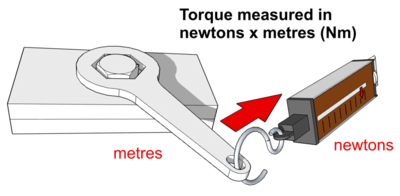Newton: Difference between revisions
From DT Online
m (Added image) |
mNo edit summary |
||
| Line 8: | Line 8: | ||
*A '''newton''' is defined as the force needed to accelerate one kilogram of mass at the rate of one metre per second squared - i.e. '''kg''' x '''m''' x '''s<sup>−2</sup>''' | *A '''newton''' is defined as the force needed to accelerate one kilogram of mass at the rate of one metre per second squared - i.e. '''kg''' x '''m''' x '''s<sup>−2</sup>''' | ||
*A '''newton''' applied at the end of a metre long '''[[Class 1 Lever|lever]]''' will exert a turning force, [https://en.wikipedia.org/wiki/Torque '''Torque'''] or '''[[Moment of Force]]''' of a '''newton metre''' ''('''N''' x '''m''')'' - this is the same as the derivation of a [https://en.wikipedia.org/wiki/Joule '''joule'''], ''(symbol: '''J''')'', named after [https://en.wikipedia.org/wiki/James_Prescott_Joule '''James Prescott Joule'''] and used to measure energy, work, heat - but '''joules''' are not used for '''Torque'''. | *A '''newton''' applied at the end of a metre long '''[[Class 1 Lever|lever]]''' will exert a turning force, [https://en.wikipedia.org/wiki/Torque '''Torque'''] or '''[[Moment of Force]]''' of a '''newton metre''' ''('''N''' x '''m''')'' - this is the same as the derivation of a [https://en.wikipedia.org/wiki/Joule '''joule'''], ''(symbol: '''J''')'', named after [https://en.wikipedia.org/wiki/James_Prescott_Joule '''James Prescott Joule'''] and used to measure energy, work, heat - but '''joules''' are not used for '''Torque'''. | ||
*A '''newton''' applied over a square metre ''(i.e. '''N/m<sup>2</sup>''')'' is used to measure '''[[Stress]]''', '''[[Young's Modulus]]''', [https://en.wikipedia.org/wiki/Ultimate_tensile_strength '''U.T.S.'''] or [https://en.wikipedia.org/wiki/Pressure '''pressure'''] and derives the '''[[S.I. Units|S.I. Unit]]''' of '''pascal''' ''(symbol: '''Pa''')'', named after [https://en.wikipedia.org/wiki/Blaise_Pascal ''' | *A '''newton''' applied over a square metre ''(i.e. '''N/m<sup>2</sup>''')'' is used to measure '''[[Stress]]''', '''[[Young's Modulus]]''', [https://en.wikipedia.org/wiki/Ultimate_tensile_strength '''U.T.S.'''] or [https://en.wikipedia.org/wiki/Pressure '''pressure'''] and derives the '''[[S.I. Units|S.I. Unit]]''' of '''pascal''' ''(symbol: '''Pa''')'', named after [https://en.wikipedia.org/wiki/Blaise_Pascal '''Blaise Pascal''']. | ||
[[Category:Terminology]] | [[Category:Terminology]] | ||
Latest revision as of 08:03, 21 December 2015
The newton (symbol: N) is the International System of Units (SI) unit of force. It is named after Isaac Newton
Note: Units named after people use capital letters for the letter symbol - but not for the unit name itself.
- A newton is defined as the force needed to accelerate one kilogram of mass at the rate of one metre per second squared - i.e. kg x m x s−2
- A newton applied at the end of a metre long lever will exert a turning force, Torque or Moment of Force of a newton metre (N x m) - this is the same as the derivation of a joule, (symbol: J), named after James Prescott Joule and used to measure energy, work, heat - but joules are not used for Torque.
- A newton applied over a square metre (i.e. N/m2) is used to measure Stress, Young's Modulus, U.T.S. or pressure and derives the S.I. Unit of pascal (symbol: Pa), named after Blaise Pascal.
